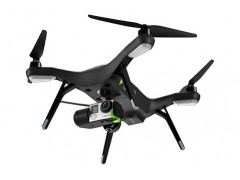


Search
|
Home » Welcome

2007 – THE VISION In 2007, Chris Anderson—NY Times best-selling author and at the time the editor-in-chief of Wired magazine—built his first drone at home with his kids using parts from a Lego Mind Machine. He got chills: when a dad and his kids can create military-grade technology on the kitchen table, something fundamental about the world has changed. But what? The kids quickly tired of the experiments, but Chris went down the rabbit hole and founded DIYDrones.com, which has since grown into the world’s largest open robotics development community. Through that site Chris met Jordi Muñoz, a nineteen-year-old college dropout and electronics wunderkind from Ensenada, Mexico, who, while bored to tears waiting for his green card to arrive, announced his genius to the DIY community by creating a fully-functioning autopilot using circuitry lifted from a Nintendo Wii remote. 2012 – THE COMMUNITY The unlikely pair founded 3D Robotics—the name alludes to the third axis, up, wher consumer robots hadn’t yet traveled—with the initial goal of supplying a global hobbyist community. They assembled their first UAV kits by hand and hacked appliances, then stuffed them in pizza boxes for shipping. But by 2012 3DR’s business had grown well beyond the DIY community, so Chris quit his job at Wired to join Jordi as 3DR’s new CEO and guide the business, scaling up piece by piece to make something much bigger. Under Chris’s stewardship, 3DR’s global neurosystem of volunteers soon created a world-class universal flight code, called APM. In collaboration with the renowned Swiss research institute ETH Zurich, 3DR used this code to develop the Pixhawk, to this day the world’s leading open autopilot platform.The 3DR platform now powers systems for of the biggest and most successful UAV companies and research institutes around the world—NASA, for instance—and has been adopted by numerous companies who are changing the way we approach agriculture, real estate, construction, search and rescue, conservation and countless other human endeavors. Pixhawk powers all 3DR drones, the heart of a vigorous and sprawling global ecosystem that will continue to drive UAV innovation for years to come. The innovations in autopilot technology by the community members power many top consumer and commercial drones today, as well as tens of thousands of personal projects. 2014 – THE PLAN In 2014 3DR turned a huge corner and took our drones mainstream. We introduced our first ready-to-fly consumer products (IRIS and IRIS+) and brought on Colin Guinn, the world’s leading UAV product development expert, to help guide the company into what’s to become the Common Era of drones. We laid claim to a larger purpose: Help people see their world from above. IRIS+ boasted several easy-to-use fully autonomous features, most notably the first true Follow Me technology in the drone industry. Follow Me allows you to go hands-free: 3DR drones can stay right with you wherver you go, automatically keeping the camera centered on you to capture your every move. Now other companies were following 3DR’s every move: We continued to lead the way for commercial applications, partnering with Intel to develop that company’s Edison microprocessor, which provides the kind of additional computing power that will enable drones to do more things for more people in more industries. In response to all of this incredible growth we co-founded the Dronecode Foundation with Linux, Qualcomm and Intel, among others, to give our community a home and a structure, and to steward the 3DR platform through this era of exponential expansion. 2015 – LIFE AFTER GRAVITY Today 3DR is the smartest and most technologically advanced drone company in the world: We’re putting computers in the sky. With a Series C round of V.C. funding led by Qualcomm, 3DR has the resources to become the first company to truly and fully integrate drone and smartphone technology. To complement and fuel this enterprise, we launched Solo, the world’s first smart drone. With the power of two full-blown 1 GHz Linux computers working in tandem, Solo gives life to world-first technologies and professional tools specifically designed to make drone photography easy for beginners and pros alike. And just like smartphones did a decade ago, Solo’s usefulness bleeds from the consumer market into the commercial. That’s because in drones we’re now seeing the convergence of numerous advanced technologies—cameras, computers, sensors, phones, the web, motors, electrical systems and custom hardware—and Solo is the first drone to fully leverage all of them. The most exciting thing about the current moment, however, is that no one is really sure wher this all will lead. A few years ago, “drone” was a dirty word. Now seven billion people will figure out how to change the world with the technology we’re creating today. Welcome to Life After Gravity. [Detailed introduction] |

